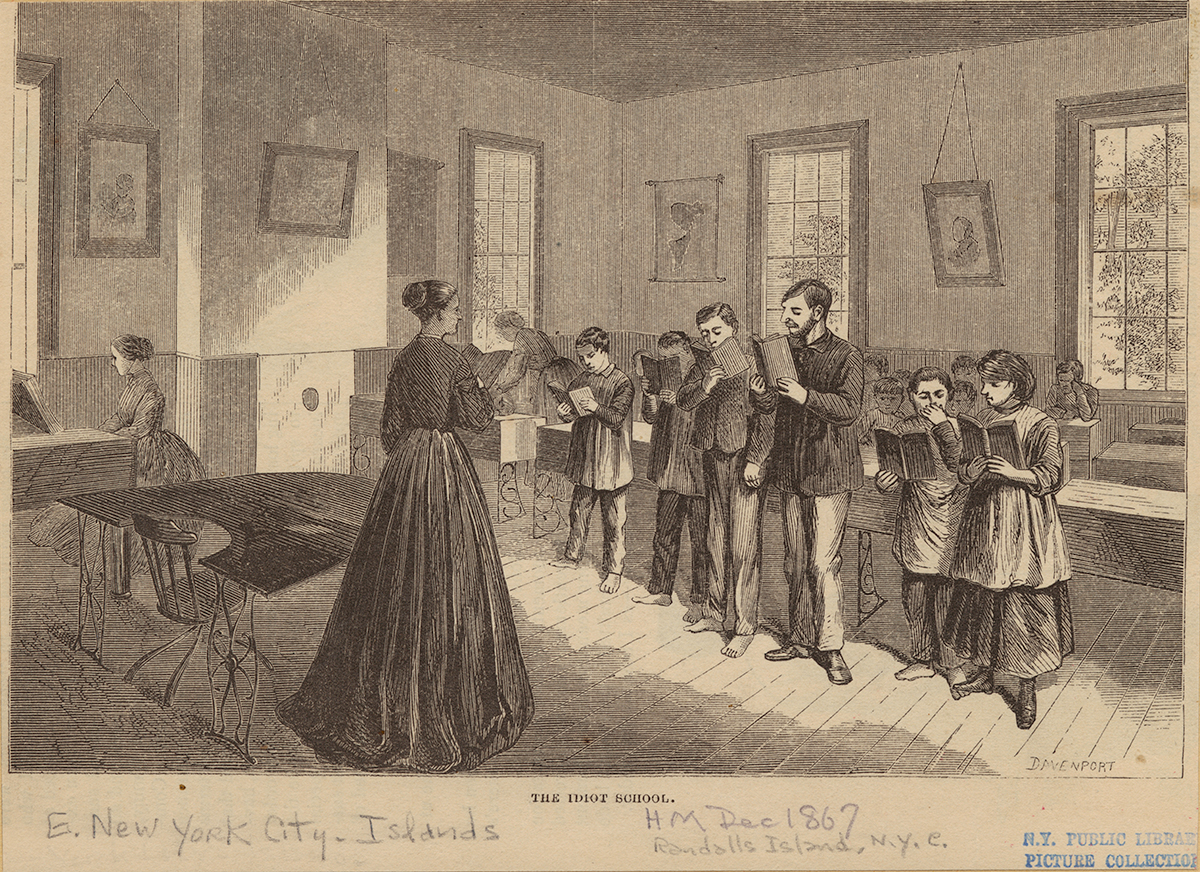You are here:
The Idiot School

Date: 1867
Caption: “The Idiot School” on Randall’s Island was founded by French educator, Édouard Séguin, in 1867. The school was designed for students with intellectual and developmental disabilities.

Édouard Séguin learned how to teach children with intellectual disabilities when he lived in France. Later, Séguin moved to the US and helped found schools around the country.
In 1866, Séguin helped found the “Idiot School” on Randall’s Island.1 At the time, terms like “idiot” and “feeble minded” were used to describe people who would today be described as having intellectual or developmental disabilities. Later, psychologists used these words to categorize people based on intelligence.2 They are not appropriate for use when describing people with disabilities today.
At the time, little was known about what are now called developmental and intellectual disabilities. Séguin had a theory that intellectual disability was caused by a “flawed relationship between a person’s will and their nervous system,” that developed shortly after birth. He believed he could train children through physical exercises, education, and “moral treatment.” While his methods helped some students, they did not help others.3
The first residential school for children with intellectual disabilities opened in Albany, New York in 1851. Similar institutions soon opened throughout the country. These “state schools” started out with a goal of education and the child’s eventual return to society. However, the educational mission of many state schools shifted to training “inmates” to care for other residents, turning the schools into custodial institutions.4 We don’t know if the school on Randall’s Island was segregated by race, but other similar institutions were segregated at the time.5
By the time the “Idiot School” opened in 1863, Randall’s Island was already home to an almshouse, orphanage, “Insane Asylum,” and the “House of Refuge,” a reform institution for “juvenile delinquents.”6 By the end of his career, Séguin worried about the growth of these schools. He thought the quality of education and care would suffer if they became too big.7 By 1915, the school had become overcrowded, facilities were run down, and teachers were underpaid. Fifty years after its opening, Mary C. Dunphy, the school’s superintendent, was removed from her position for neglect.
-
James Trent, Inventing the Feeble Mind: A History of Intellectual Disability in the United States (Oxford: Oxford University Press, 2016), 81. ↩︎
-
JoElla Straley, “It Took a Eugenicist to Come Up With ‘Moron,’” February 10, 2014, in Code Switch, produced by National Public Radio, podcast, https://www.npr.org/sections/codeswitch/2014/02/10/267561895/it-took-a-eugenicist-to-come-up-with-moron. ↩︎
-
Édouard Séguin, Idiocy: And its Treatment by the Physiological Method (New York: W. Wood & Company, 1866). ↩︎
-
Sarah F. Rose, No Right To Be Idle: The Invention of Disability, 1840s-1930s (Chapel Hill: University of North Carolina Press, 2017), 66-77. ↩︎
-
Kim E. Nielsen, A Disability History of the United States (Boston: Beacon Press, 2012). ↩︎
-
John Francis Richmond, New York and its Institutions, 1609-1871: A Library of Information, Pertaining to the Great Metropolis, Past and Present (New York: E.B. Treat, 1872), 562. ↩︎
-
Trent, Inventing the Feeble Mind, 76. ↩︎
Categories: Manhattan, K-12 organizing, adult education
Tags: racist segregation, Disabled people, intellectual disabilities, disability labels, curriculum, photography, imagery, and visual representation, newspapers and the media, institutionalization of Disabled people and people labeled disabled
This item is part of "The Beginnings of Special Education" in "Seeking Equity for Disabled Students"
Item Details
Date: 1867
Creator: Harper’s Magazine
Copyright: Public domain. Courtesy of New York Public Library Digital Collections.
How to cite: “The Idiot School,” Harper’s Magazine, in New York City Civil Rights History Project, Accessed: [Month Day, Year], https://nyccivilrightshistory.org/gallery/idiot-school-randalls-island.
Questions to Consider
- Look carefully at the illustration of the classroom. What do you notice about who is there and what they are doing? What do you notice about the classroom space? How does it compare to your classrooms today? What questions do you have about this image?
- Why did Edouard Séguin and his colleagues think that students with intellectual and physical disabilities needed to go to school away from their families and communities? Do you agree with their ideas?
- How do people with intellectual and developmental disabilities experience school in New York City today? How is their experience similar to the school on Randall’s Island? How is it different?
References
How to Print this Page
- Press Ctrl + P or Cmd + P to open the print dialogue window.
- Under settings, choose "display headers and footers" if you want to print page numbers and the web address.
- Embedded PDF files will not print as part of the page. For best printing results, download the PDF and print from Adobe Reader or Preview.
